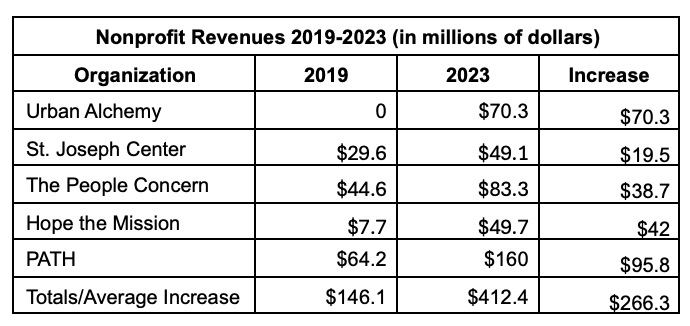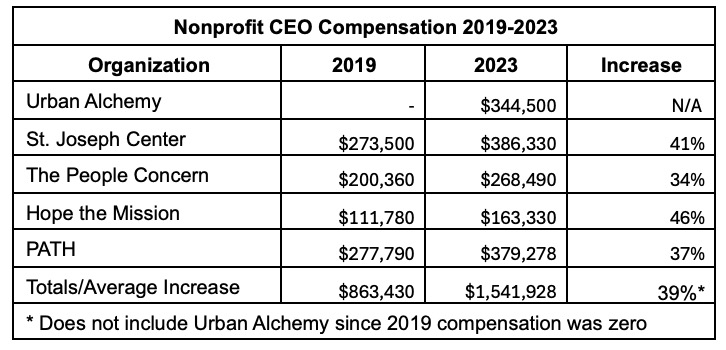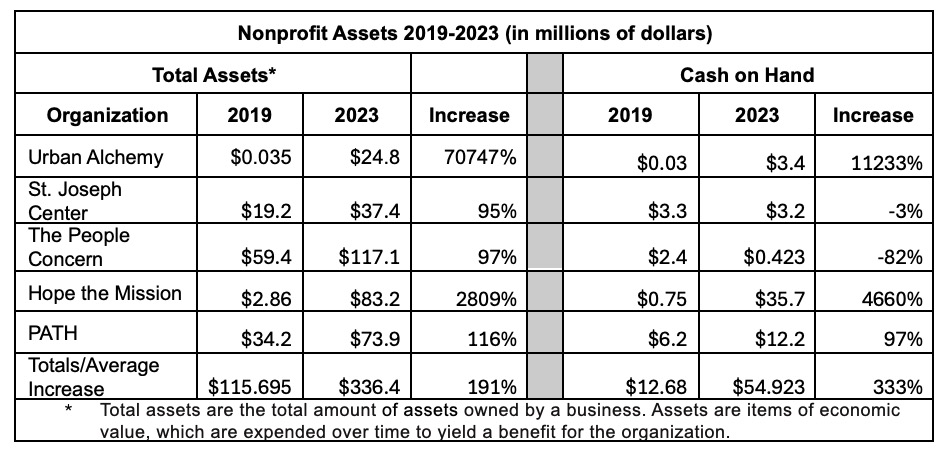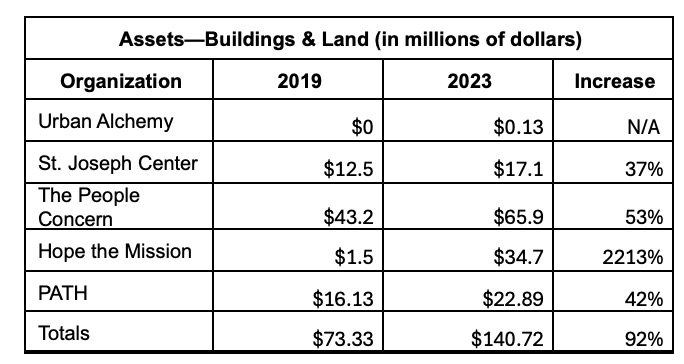Comments
iAUDIT - This is the last in a series on the major players in Los Angeles’ homelessness programs, and covers the most opaque group, the network of nonprofits that serve the region’s unhoused population. In May 2023, the LA Times estimated there were about 8,000 people working for 200 organizations throughout LA County. Many, like SOFESA , are fairly small and serve the homeless in specific areas like Pacific Palisades. Others, like PATH and The People Concern, are large corporations with budgets well into the tens of millions or more. This column will focus on the large nonprofits, since they most effect policy.
Before diving into the details of LA’s nonprofit landscape, its important to understand the nature of nonprofit organizations (NPO’s). There are many types of nonprofit organizations, but I’m focusing on what’s known as 501(3)c entities; these exist for charitable or social service purposes. Donating to them is tax deductible, and they generally pay little or no taxes on their revenues. Contrary to what some people think, there are no limits on an NPO’s income. The American Red Cross’ 2023 revenue was more than $3.2 billion, rivaling the largest private companies. 501(3)c nonprofits are prohibited from political activities, but they can align with a different kind of NPO, known as 501(c)4 organizations, to advocate for favored policies. They can also engage with for-profit organizations, as long as they pay taxes on any revenues. For example, I was treasurer for a church that rented a small parcel of its land to a cell tower company. The church had to pay property taxes on the parcel since it was leased to a for-profit company. Due to their tax-exempt status, NPO’s must file a tax form known as a Form 990, which is a public document.
In keeping with my original baseball theme, think of large corporate homelessness nonprofits as high-priced star players who never quite reach their potential. Management pins its hopes for a successful season on these stars, but they don’t live up to the hype. Local government depends on these organizations for an array of services, including outreach, shelter management, social and other support operations, and rent subsides. The larger organizations often subcontract with smaller ones for direct services. Nonprofits populate many links on the service chain. Using a transitional shelter as a sample, the City of LA may contract with LAHSA for shelter management. LAHSA might contract with a large nonprofit like PATH. PATH could contract with one or more other NPO’s for case management, social services, and providing meals. That’s where the problems start.
As we know from comments at the October 2, 2024 hearing before federal Judge David Carter, LAHSA has been paying NPO’s without requiring supporting documentation. Its contracts contain few or no performance measures; they are process-based, meaning they pay organizations for performing specified actions regardless of their effectiveness. The City, in turn, pays LAHSA without asking for documentation. Indeed, City Controller Mejia told the court the City routinely pays LAHSA 25 to 30 percent of LAHSA’s program costs in advance. Combined with the lack of documentation, paying costs in advance is an invitation for fraud, since its easy to back into the number to match the amount billed.
Who are some of the major players in LA’s nonprofit world, and what have they accomplished? I picked five representative organizations because, for better or worse, they seem to appear most often in news stories and their leaders often accompany elected officials at news events. In alphabetical order, they are:
- Hope the Mission, an NPO that does most of its work in the San Fernando Valley
- PATH (People Assisting the Homeless), a citywide provider
- The People Concern, another citywide provider
- St. Joseph Center, also citywide, but with a particularly strong presence on the Westside
- Urban Alchemy, engaged primarily in street outreach—it is a provider for the City’s CIRCLE (Crisis and Incident Response through Community-led Engagement) teams.
Except for Urban Alchemy, these nonprofits have been part of LA’s homeless programming for several years. Urban Alchemy started in San Francisco in the late 20-teens, and spread to LA within the last few years.
Using the links above, look at each organization’s website. There is a very good chance you’ll see photos of happy scrubbed people smiling contently at the camera, accompanied by quotes about how the organization rescued them from the streets. What you won’t see are the thousands of people left unserved and ignored, or the thousands more who enter shelters, only to fall back into homelessness.
To measure what NPO’s have achieved in relation to their budgets, I looked at the years between 2019 and 2023. 2019 was the last full year before the pandemic, and 2023 is the latest year we can access public tax documents. First, let’s look at the increase in homelessness. LAHSA’s 2019 PIT count showed 58,936 unhoused people in LA County. By 2023, it had increased 27.7 percent to 75,300. Despite the efforts of government and nonprofit agencies, homelessness increased.
Now let’s look at some key financial information. These data were taken from each organization’s federally filed Form 990, so it comes from the agencies themselves.

Nonprofit revenues increased by more than $266 million in four years. Much of this money came from federal CARES and ARPA funding for COVID relief. As revenues increased, so did CEO compensation:

While homelessness was increasing, CEO compensation was rising even faster. Even taking Urban Alchemy’s CEO’s salary out of the mix, executive compensation increased an average of 39 percent. The NPO’s were also seeing healthy expansion in their total assets.

The amount of liquid cash on hand has seen astronomical increases. Besides cash on hand, assets can include buildings, and in the case of these organizations, many have become large real estate holders, as you can see in the table below. In the Westside Current, Angela McGregor offers an excellent analysis on how nonprofits have become major players in LA’s developer landscape.

While some of the organizations that have had increases in building/real estate assets have also seen increases in liabilities, (for loan liabilities and other delayed costs), they’ve also benefitted from more cash on hand.
What do the data in the charts tell us? First, the huge increases in funding—and housing--have done nothing to alleviate the homelessness crisis. If the money dedicated to current homeless programming made a difference, perhaps the expense could be justified. But we’ve seen no such improvement. Second, executive compensation has nothing to do with performance. Other than having a knack for growing their revenues, there is no performance-based reason for any of the CEO’s to receive such generous raises, which far outpaced inflation. Third, judging by the increases in cash on hand, most of these organizations have not been spending their new-found money on programming. Although the People Concern and St. Joseph Center have had decreases in liquid cash, they both saw major increases in other assets, such as buildings, (and the decreased did nothing to hinder generous raises for the CEO’s). Ironically, PATH’s CEO was recently quoted in an LAist article on the sluggish pace of reimbursements from government agencies, lamenting the money the city owes her agency, while sitting on $12 million in cash and seeing a 149 percent increase in revenues in four years.
PATH’s CEO’s statement leads us to the fourth, and perhaps most important, point. A lot of these funds came from COVID relief money, which is beginning to dry up. At the same time, Measure H, the quarter-cent sales tax voters approved in 2017, will sunset in 2027. As I noted, in their rush to enter the real estate market, NPO’s have incurred significant long-term liabilities, and need revenue to pay off current and future debt. Like Gold Rush towns facing the end of boom times as the mines run dry, large nonprofits are casting about for new ways to make money. One way, as shown by the increase in non-cash assets, is by building their real estate portfolios through government programs like the City’s Project Homekey, which has purchased more than $800 million in hotel and motel rooms for housing over the past few years, (while leaving about 50 percent vacant for months).
The other way to raise funds is by finding a way to guarantee a permanent revenue stream. That explains why many nonprofits are sponsoring Measure A, the proposal to permanently increase Measure H’s quarter-cent sales tax to a half-cent. Passing Measure A would provide the revenue stream nonprofits and developers need to maintain their healthy budgets. As I detailed in a recent Westside Current article, Measure A is a cynical attempt by providers to continue a nonstop cash flow while doing nothing to restructure ineffective homelessness programs. The City of LA created a recently-disclosed plan to spend $20 billion over the next 10 years on homelessness, with no significant changes in programming.
Large NPO’s also affect homelessness policy. Their CEO’s commonly accompany local officials at news conferences or public events. Despite their demonstrable lack of success, public officials consult them as subject matter experts, to the point where they uncritically parrot NPO slogans like “only housing cures homelessness” at every opportunity. By controlling the narrative around homelessness, NPO’s have controlled how it is addressed. As I detailed in this column, service contracts are often written to favor large organizations, and they pay for processes instead of results.
Returning one last time to our baseball analogy, local government is like the baseball manager who refuses to bench underperforming players. They keep spending money, hoping the player will turn things around. And the players themselves depend on bravado in the absence of performance, hoping bluster will disguise their shortcomings. Instead of releasing the poor player, local government doubles down telling fans it’s just a matter of time before they see the promised performance.
Now we’ve seen how all four major players: the City of LA, the County, LAHSA, and nonprofits, have failed to coordinate their efforts to end homelessness. Like a team whose players can’t work together, each pursues its own failed policies. It seems the only thing they’re capable of is protecting one another and asking for more funds. But we must remember we, the voters, are the true team owners, and we have it in in our power to demand change and insist all the players work toward a common goal. Unless and until that happens, we must accept that the consequences will be more people on the street, and more needless deaths every night.
(Tim Campbell is a resident of Westchester who spent a career in the public service and managed a municipal performance audit program. He focuses on outcomes instead of process. Tim is a regular CityWatchLA contributor.)
















